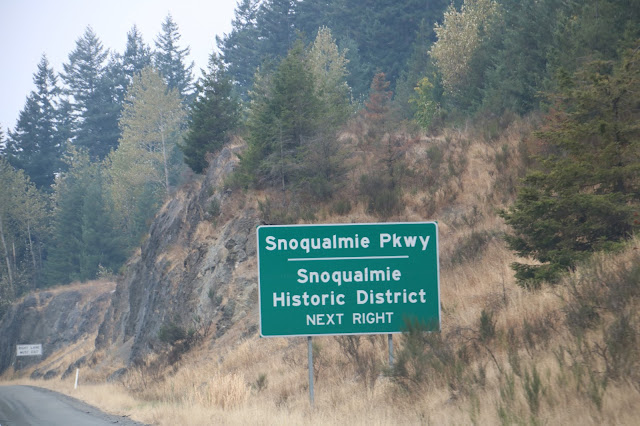Day 1 - Toronto to Chesterton IN
Day 2 - Chesterton IN to Rochester MN
Day 3 - Rochester MN to Lincoln NB
Day 4 - Lincoln NB to Denver CO
Weekly recap with more photos
Day 5 - Denver CO to Rapid City SD
The Curtis Hotel Denver CO funky themed floors
Day 6 - Rapid City SD Mount Rushmore City of Presidents
Day 7 - Rapid City SD to Billings MT Crazy Horse and Little Big Horn
Day 8 - Billings MT to Driggs ID
Day 9 - Jackson Hole WY and Grand Teton NP
Day 5 - Denver CO to Rapid City SD
The Curtis Hotel Denver CO funky themed floors
Day 6 - Rapid City SD Mount Rushmore City of Presidents
Day 7 - Rapid City SD to Billings MT Crazy Horse and Little Big Horn
Day 8 - Billings MT to Driggs ID
Day 9 - Jackson Hole WY and Grand Teton NP
September 16
Out our window as we rose.
On the road, I love the contrast of the yellow and blue.
That is smokey sunshine. The smoke is from the fires.
Snoqualmie, a rural community founded early in the Puget Sound region's history, is located about 30 miles east of Seattle along the Snoqualmie River just above Snoqualmie Falls.
The Snoqualmie tribe considers the falls to contain powerful magic for peace. The tribe has always been a peaceful tribe -- perhaps too peaceful. When settlers first arrived in the 1850s, Chief Patkanim sided with them against warrior tribes. It was Chief Patkanim who signed the Point Elliott Treaty in 1855, which ceded all of the tribe's land to the United States. In return, the Americans never repaid them and never gave them a reservation. Many of the Snoqualmie ended up living in poverty on land that was once theirs.
We settled here for lunch.
Nice name - Enchanted Parkway, it seems there was an amusement park called Enchanted Village located near here but it was renamed to Wild Waves.
Discovery Bay is a small bay adjoining the Strait of Juan de Fuca on the Olympic Peninsula in Washington state; this body of water was also historically called Port Discovery.
The bay was named by George Vancouver after the Discovery, a ship used in his 1792 expedition of the area.
Jamestown S’Klallam Longhouse.
.
The entire Olympic Peninsula is rich in Native American history and culture. There are eight local tribes residing on reservations along the coastal areas of the Peninsula who ceded their land back in 1855 and 1856: Lower Elwha Klallam, Jamestown S’Klallam, Port Gamble S’Klallam, Skokomish, Quinault, Hoh, Quileute, and Makah. Today, ancestors of the original people remain and work in conjunction with the Olympic National Park and cities within the Peninsula to honor their access to the National Park and other natural areas for traditional land use and spiritual beliefs and practices.
.
The Klallam people once spanned the entire northern portion of the Olympic Peninsula with 33 villages. Downtown Port Angeles was once the site of a historic village called č̕ixʷícən (Tse-whit-zen) believed to be over 2,700-years-old.
The City's harbour was dubbed Puerto de Nuestra Señora de los Ángeles (Port of Our Lady of the Angels) by Spanish explorer Francisco de Eliza in 1791. By the mid-19th century, after settlement by English speakers from the United States, the name was shortened and partially anglicized to its current form, Port Angeles Harbor.
Port Angeles is home to Peninsula College. It is the birthplace of football hall of famer John Elway and residents include writers and artists.

























A beautiful part of the continent!
ReplyDelete